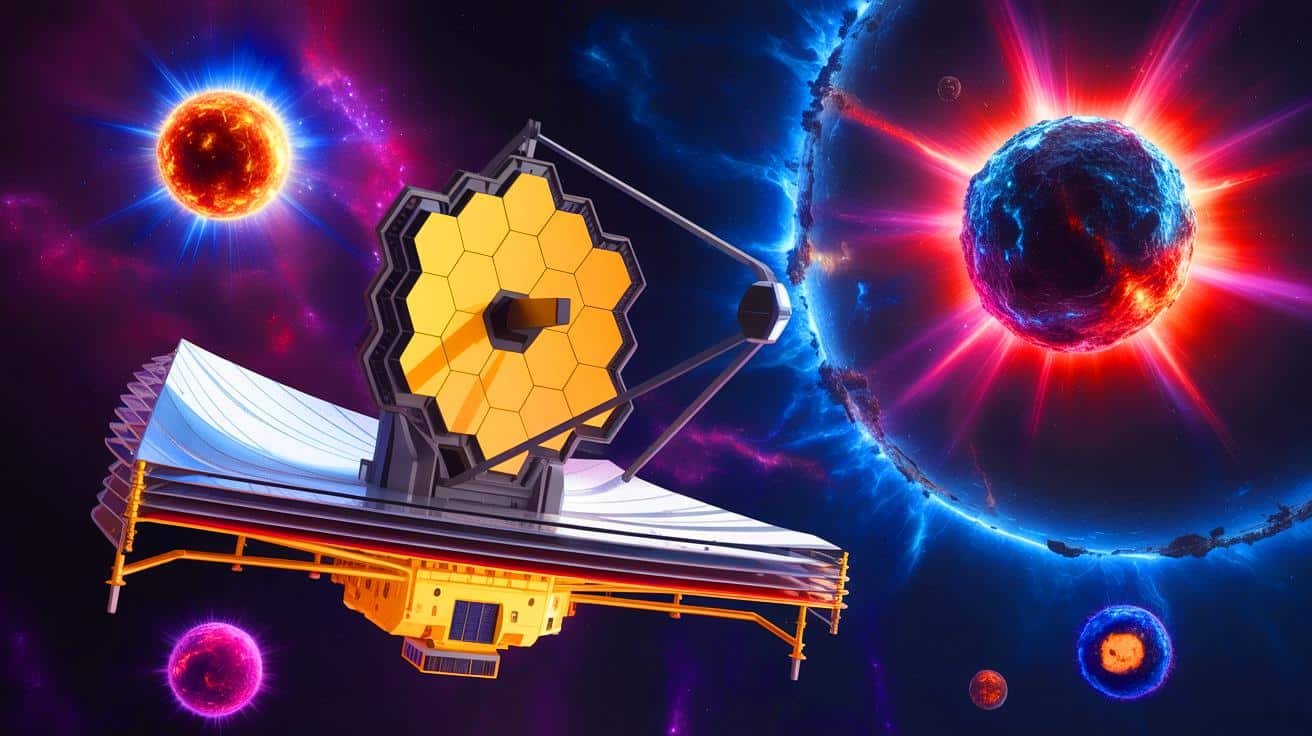IN A NUTSHELL
🔭 Astronomers may have discovered supermassive dark stars using the James Webb Space Telescope.
💡 These stars are theorized to be powered by dark matter annihilation, offering insights into the early universe.
📊 The research team identified four potential candidates that match the expected characteristics of dark stars.
🛰️ If confirmed, these findings could transform our understanding of dark matter and supermassive black holes.
Recent advancements in astronomical research have taken an intriguing turn with the potential discovery of a new class of celestial objects: supermassive dark stars. Utilizing the cutting-edge capabilities of the James Webb Space Telescope (JWST), a team of astronomers has identified several candidates that might redefine our understanding of the early universe. These findings could not only shed light on the enigmatic nature of dark matter but also on the formation of supermassive black holes. As the science community digests these revelations, the implications for astronomy and our comprehension of cosmic history are profound.
Understanding Dark Stars
The concept of dark stars challenges traditional astronomical notions. Unlike conventional stars fueled by nuclear fusion, dark stars are theorized to be powered by dark matter annihilation. This notion was first proposed by Katherine Freese and her colleagues, who suggested that these celestial bodies could have formed shortly after the Big Bang. According to the theory, dark stars are composed mainly of hydrogen and helium, much like regular stars, but with a critical difference: they are sustained by the energy released when dark matter particles collide and annihilate each other.
Such a mechanism not only provides a potential explanation for the immense brightness of these objects but also offers insights into the early universe’s conditions. The presence of dark matter, which makes up a significant portion of the universe’s mass, has long puzzled scientists. These stars could offer a unique window into understanding this elusive component of the cosmos, potentially leading to breakthroughs in particle physics and cosmology.
From Theory to Observation
The journey from theoretical speculation to empirical evidence has been a long road for the concept of dark stars. Initially theorized over a decade ago, the idea remained largely untested until the advent of the JWST. This powerful telescope, with its advanced spectroscopic capabilities, allowed researchers to observe objects at unprecedented distances. The recent study conducted by Cosmin Ilie and his team marks a significant milestone in this journey.
By analyzing the spectral data obtained from JWST, the team identified several candidates that match the characteristics expected of dark stars. These findings, if confirmed, could validate the initial theories proposed by Freese and her colleagues. The ability to observe these objects directly not only reinforces the theoretical framework but also opens the door to a deeper understanding of the universe’s earliest epochs.
Identifying the Candidates
The identification of potential dark star candidates was a meticulous process. Ilie and his collaborators focused on data from JWST’s NIRCam and NIRSpec instruments. Among the candidates, four objects stood out due to their exceptional brightness and compact nature. These characteristics align with the theoretical predictions for dark stars, making them prime subjects for further investigation.
One of the key indicators supporting the dark star hypothesis is an absorption feature at 1640 Angstroms, linked to singly ionized helium. The presence of this feature in the spectrum of one of the candidates provides a tantalizing hint that these objects are indeed dark stars. While the signal is still tentative, further observations could solidify these findings, marking a significant breakthrough in our understanding of the cosmos.
The Implications for Astronomy
The potential discovery of dark stars carries profound implications for astronomy. These objects could serve as a bridge in understanding the formation of supermassive black holes, which remain one of the universe’s most enduring mysteries. The rapid rise of these colossal structures in the early universe has puzzled scientists for decades, and dark stars could offer a viable explanation.
Moreover, the study of dark stars could revolutionize our understanding of dark matter. By examining the properties of these stars, astronomers might infer the characteristics of the dark matter particles that power them. This could lead to groundbreaking discoveries in particle physics, offering clues to one of the most significant unanswered questions in modern science. The pursuit of these answers is not just a scientific endeavor but a quest to unlock the fundamental secrets of the universe.
As astronomers continue to explore the universe with the James Webb Space Telescope, the potential identification of supermassive dark stars marks a pivotal moment in the field. These findings not only challenge existing paradigms but also open new avenues for research. With further study, these objects could provide critical insights into the nature of dark matter and the early universe’s evolution. How will these discoveries shape our understanding of the cosmos, and what other secrets does the universe hold waiting to be uncovered?
This article is based on verified sources and supported by editorial technologies.
Did you like it? 4.5/5 (30)

